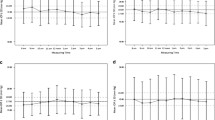Abstract
Background
A case-controlled prospective study was conducted to evaluate the diurnal variation of intraocular pressure (IOP); the mean, the amplitude of variation and the peak and trough times of pressure readings in the suspected open-angle glaucoma patients as compared with a control group. We also looked at the outcome of these suspects after diurnal variation of IOP measurements.
Methods
Diurnal variation of intraocular pressure was measured in 202 eyes of suspected open-angle glaucoma patients and 100 control eyes, at 4-hourly intervals for 24 hours (phasing). Based on the phasing results, optic disc changes and visual field defects, the patients were diagnosed as primary open angle glaucoma (POAG), normal tension glaucoma (NTG), ocular hypertension (OHT), or physiologic cup (PC), or still remained as glaucoma suspects due to inconclusive diagnosis. The last group (glaucoma suspects) was then followed up 6-monthly for their eventual outcome.
Results
The highest percentage of suspected glaucoma patients had peak (maximum) readings in the mid-morning (10–11 a.m.) and trough (minimum) readings after midnight (2–3 a.m.); the highest percentage of control group had peak readings in the late evening (6–7 p.m.) and trough readings after midnight (2–3 a.m.). The mean amplitude of variance was 6 mm Hg in suspected glaucoma group and 4 mm Hg in the control group. After ‘phasing’, 18.8% of the suspected glaucoma patients were diagnosed as POAG, 16.8% as NTG, 5% as OHT, and 28.7% as physiologic cup; 30.9% remained as glaucoma suspects. After 4 years follow-up, 70% of the glaucoma suspects still remained as glaucoma suspects, 6.7% developed NTG and another 6.7% POAG; 16.6% were normal.
Conclusions
Serial measurement of IOP ( phasing) in a 24-hour period is still needed, in order not to miss the peak and the trough IOP readings in suspected open-angle glaucoma patients, which helps in better management of glaucoma. Among 30.9% of patients who remained as glaucoma suspects after the initial phasing, 13.4% developed NTG/POAG over a period of 4 years.





Similar content being viewed by others
References
Armaly MF (1965) On the distributions of applanation pressure. Statistical features and the effect of age, sex and family history of glaucoma. Arch Ophthalmol 73:11–18
Bulpitt CJ, Hodes C, Everitt MG (1975) Intraocular pressure and systemic blood pressure in the elderly. Br J Ophthalmol 59:717–720
Drance SM (1960) The significance of the diurnal tension variations in normal and glaucomatous eyes. Arch Ophthalmol 64:494–496
Hyams SW (1982) The effect of hospitalization on intraocular pressure. Am J Ophthalmol 94:519–521
Langerhorst CT (1988) Automated perimetry in glaucoma. In: Fluctuation behaviour and general and local reduction of sensitivity. Kugler, The Netherlands, p 136
Leske MC, Connell AMS, Wu SY (2001) Risk factors for open-angle glaucoma. The Barbados Eye Studies. Arch Ophthalmol 119:89–95
Mauger RR, Likens CP, Applebaum M (1984) Effects of accommodation and repeated applanation tonometry on intraocular pressure. Am J Optom Physiol Opt 61:28–30
Morley AMS, Murdoch I (2006) The future of glaucoma clinics. Br J Ophthalmol 90:640–645
Sacca SC, Rolando M, Marletta A (1998) Fluctuations of intraocular pressure during the day in open-angle glaucoma, normal tension glaucoma and normal subjects. Ophthalmologica 212:115–119
Varma R, Tielsch JM, Quigley HA, Hilton SC (1994) Race, age, gender, and refractive error related differences in the normal optic disc. Arch Ophthalmol 112:1068–1076
Weih LM, Nanjan M, Mc Carty CA (2001) Prevalence and predictors of open-angle glaucoma. Results from the visual impairment project. Ophthalmology 108:1966–1972
Wilensky JT (1993) Individual variability in the diurnal intraocular pressure curve. Ophthalmology 100:940–944
Xi XR (1996) Diurnal variations of intraocular pressure in normal and ocular hypertensive subjects of China. J Pak Med Assoc 46:171–174
Author information
Authors and Affiliations
Corresponding author
Additional information
The authors have no financial support in the writing of this paper.
Rights and permissions
About this article
Cite this article
Tajunisah, I., Reddy, S.C. & Fathilah, J. Diurnal variation of intraocular pressure in suspected glaucoma patients and their outcome. Graefes Arch Clin Exp Ophthalmol 245, 1851–1857 (2007). https://doi.org/10.1007/s00417-007-0681-7
Received:
Revised:
Accepted:
Published:
Issue Date:
DOI: https://doi.org/10.1007/s00417-007-0681-7




